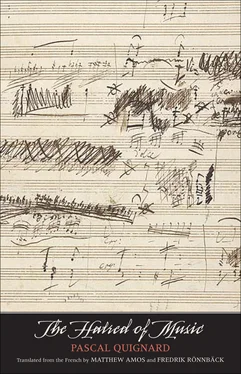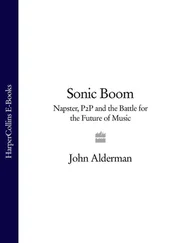
André Leroi-Gourhan, in The Art of Prehistoric Man , boils down the question to a single sentence: why did the thought of bison and horse hunters “bury” itself at the time of the glacial retreat?

I will present the speculation specific to this short treatise in the following manner: these caves are not sanctuaries for images.
I maintain that Paleolithic caves are musical instruments whose walls were decorated.
They are nocturnal resonators that were painted in a manner that was by no means panoramic: they were painted in the invisible. The choice of the decorated walls was based on echoes. The place of acoustic doubles is the echo: they are echo chambers. (In the same way that the space of visible doubles is the mask: bison masks, stag masks, masks of birds of prey with hooked beaks, bison-men puppets.) The stag-man depicted at the end of the cul-de-sac in the Cave of the Trois Frères is holding a bow. I will not distinguish the hunting tool from the first lyre, just as I did not distinguish Apollo the archer from Apollo the citharede.

Cave paintings begin where we can no longer see our hands before our eyes.
Where we see the color black.
Echoes are guides and reference points in the silent darkness that they enter and where they search for images.

Echoes are the voice of the invisible. The living do not see the dead in the light of day. Whereas they see them at night in their dreams. In echoes, the emitter cannot be found. It is a game of hide-and-seek between the visible and the audible.

The first humans painted their visiones nocturnae by letting themselves be guided by the acoustic properties of certain walls. In the caves of Ariège, the Paleolithic shaman-painters depict roaring, just in front of the jaws or muzzle of wild beasts, in the form of a group of strokes. These strokes or even incisions are their roar. They also painted masked shamans holding their birdcalls or their bows. Resonance, in the great resonant sanctuaries, was tied to apparition, behind the curtain of stalagmites.
To the light of the grease lamp, which one by one revealed the animal epiphanies shrouded in darkness, responded the music of calcite lithophones.

In Malta, in the Hypogeum cave, a resonating cavity has been hollowed out by human hands. Its frequency is ninety hertz, the amplification of which proves to be terrifying provided that the emitted voices are low.
R. Murray Schafer made an inventory in his books of all the ziggurats, temples, crypts, and cathedrals that echo, that reverberate, that constitute a polyphonic labyrinth.
Echoes engender the mystery of the alter ego world.
Lucretius simply stated that all places that echo are temples.

In 1776, Vivant Denon visits the echoing cave of the Sibyl and notes in his travel journal: “There is not a more impressive sound. It is perhaps the most beautiful acoustic body that exists.”

In the Cave of the Trois Frères, the shaman with reindeer antlers, reindeer ears, horse tail, lion paws, has the eyes of an owl: he has the eyes of a predator that relies on hearing. Of cavernicoles.

The Aranda verb for being born is alkneraka: becoming-eyes.

The inhabitants of ancient Sumer named the place where the dead go: the Land-of-No-Return.
Sumerian texts describe the Land-of-No-Return thus: the breath of the dead barely survives, asleep, covered in dirt and feathers, wretched, like “nocturnal birds living in caves.”

Isis, when she offered the model of lamentation to the first Egyptians, said in her lamentation that, when eyes do not see, eyes desire.
The hymn makes clear, to the detriment of language, that the voice that hails the dead does not reach their ears. The voice only names them. It can only summon the pain of those who are deprived of their loved ones.
The myth says that when Isis began the first lamentation — the lamentation over Osiris’s castrated corpse, whose sex is lost — as soon as Isis sang, the child of the Queen of Byblos died.

The first figurative narration was painted at the bottom of a well, itself at the bottom of a completely dark cave. It is a dying, ithyphallic man knocked down on his back, a bison, gored by a spear, charging at him, a staff surmounted by the head of a hook-beaked bird.
The last religion that persists in the space where I live depicts a dying man.
It is said, in the New Testament , that Christ was blindfolded when he was slapped.
Every God bleeds in the dark.
God bleeds only in hearing and in the night. Outside the night and caves, he shines like a sun.
Isaac can no longer see. He is in the night. Jacob says: “I did not bring you a ewe killed by wild beasts.”
Jacob did not bring a ewe killed by wild beasts but he covered his arms with it.
Isaac feels him and says: “The voice is Jacob’s but the arms are Esau’s” and he blesses him.
He reflects: “His voice has not yet changed and yet his body is covered in hair.”

As a child, I sang. As an adolescent, like all adolescents, my voice broke. But it remained muffled and lost. I passionately buried myself in instrumental music. There is a direct link between music and voice change. Women are born and die in a soprano that seems indestructible. Their voice is their reign. Men lose their childhood voices. At thirteen, they become hoarse, quaver, bleat. It is curious that our language still says that they bleat. Men are counted among the animals whose voices break. Within the species, they make up a species that sings in two voices.
They can be defined, from puberty on: humans who have shed their voice.
In the male voice, childhood, nonlanguage, the relationship with the mother and her dark water, with the amnion, as well as the obedient elaboration of the first emotions, finally the child’s voice that attracts the maternal language, are a snake’s coat.
Men therefore cut off their voice change as they cut off their testicles. A forever childlike voice. They are castrati.
Or men compose with their lost voice. We call them composers. They recompose as best they can an acoustic territory that does not change, unchangeable.
Or perhaps still, humans compensate with instruments for their bodily lack and the acoustic abandonment in which the deepening of their voice has plunged them. They thus regain the both puerile and maternal high registers of nascent emotion, of their acoustic home.
We name them virtuosi.

Human castration can be defined as the Neolithic domestication of the voice. Intraspecific domestication that lasted from the Neolithic until the end of the eighteenth century in Europe. It reflects the underground circumcisions in shamanic caves where dying to childhood and being reborn mutated into an animal-man, into a hunter, was one and the same metamorphosis.
Читать дальше













